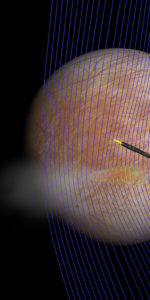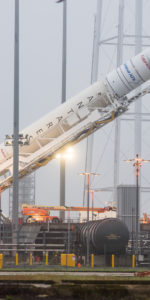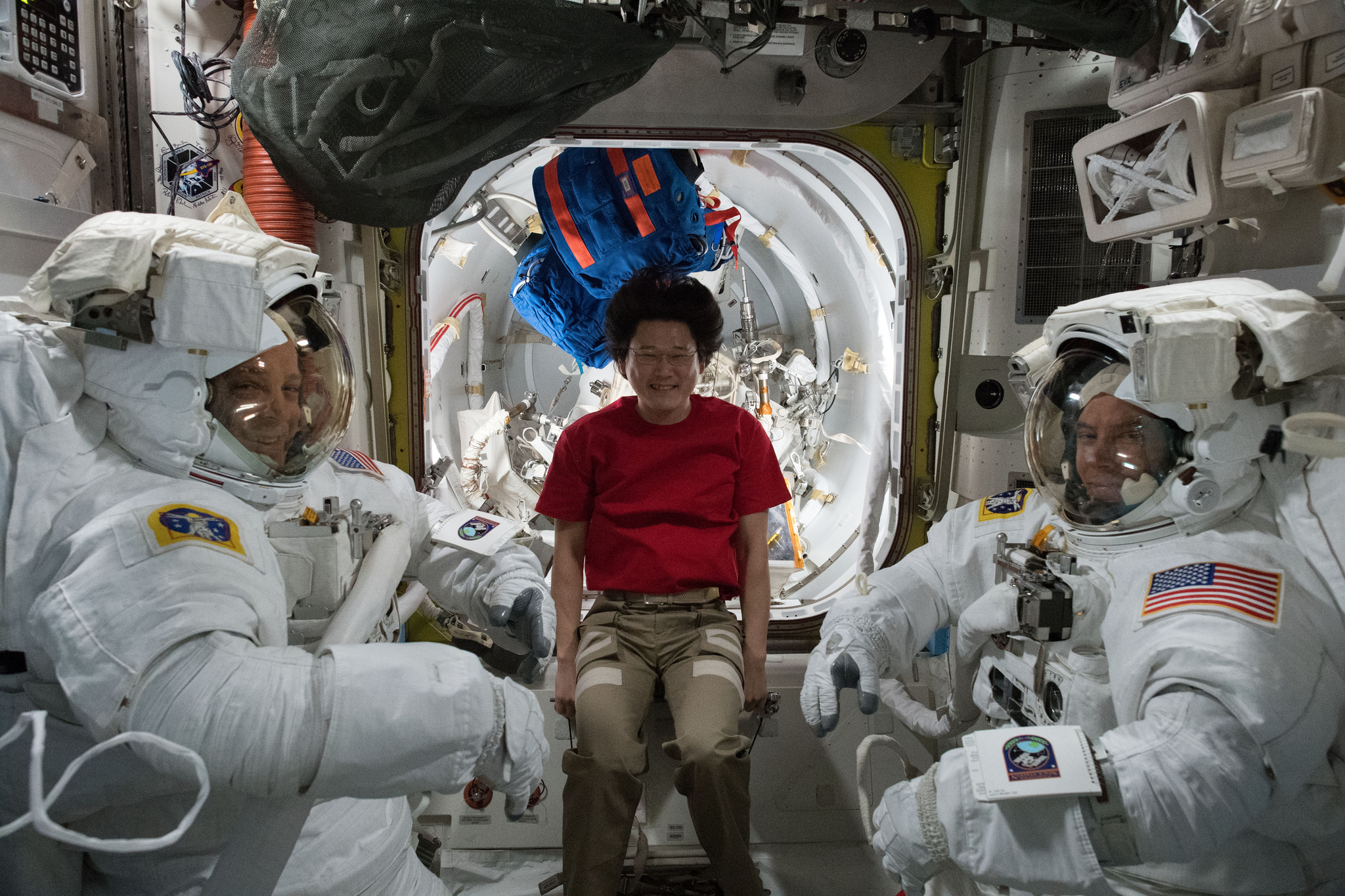
Expedition 55 spacewalkers Drew Feustel and Ricky Arnold have completed a six-hour and 31-minute session of Extravehicular Activity (EVA), outside the International Space Station (ISS), during which they removed a 235-pound (107 kg) Pump Flow Control Subassembly (PFCS) from a spare parts platform to the Dextre “hand” of the 57.7-foot-long (17.6-meter) Canadarm2 robotic arm. It will be robotically relocated to the P-6 truss, where it will be further inspected and analyzed, before potential future use as a viable spare for the station’s cooling system. Meanwhile, Feustel and Arnold brought a leaky PFCS from Dextre for storage and removed and replaced a failed external camera group and a space-to-ground transmitter receiver controller, the latter of which provides critical redundancy for the station’s Ku-band communications infrastructure.
The completion of today’s activities positions Feustel—who was making his eighth career EVA—within the Top Ten most seasoned spacewalkers of all time, with a total of 54 hours and 59 minutes. Having already performed three EVAs to service and upgrade the Hubble Space Telescope (HST) in May 2009, another three on shuttle Endeavour’s final mission in May 2011 and, more recently, a further excursion in March 2018, Feustel sits in seventh place, behind Jerry Ross and slightly ahead of Rick Mastracchio. For his part, Arnold wrapped up his fourth EVA in what also represented the 50th spacewalk performed out of the station’s two-piece Quest airlock by members of an incumbent station crew.
Although today’s EVA marks the 210th time since December 1998 that astronauts or cosmonauts have ventured outside the ISS to perform construction, maintenance or repair tasks, it was also the 50th occasion that the 18-foot-long (5.5-meter) Quest airlock—which sits on the starboard side of the Unity node—has been used by station-based “Stage” spacewalkers. Delivered and installed by the crew of shuttle mission STS-104, Quest has now seen 116 EVAs by both shuttle and ISS spacewalkers. However, this large number can be broken down to only 50 EVAs actually performed by resident ISS crew members, the first of which took place in February 2002. Since February 2002, those 50 EVAs have aided the installation, activation and relocation of components of the station’s gigantic Integrated Truss Structure (ITS) and several pressurized modules, as well as a multitude of repairs and replacement of hardware over the years.
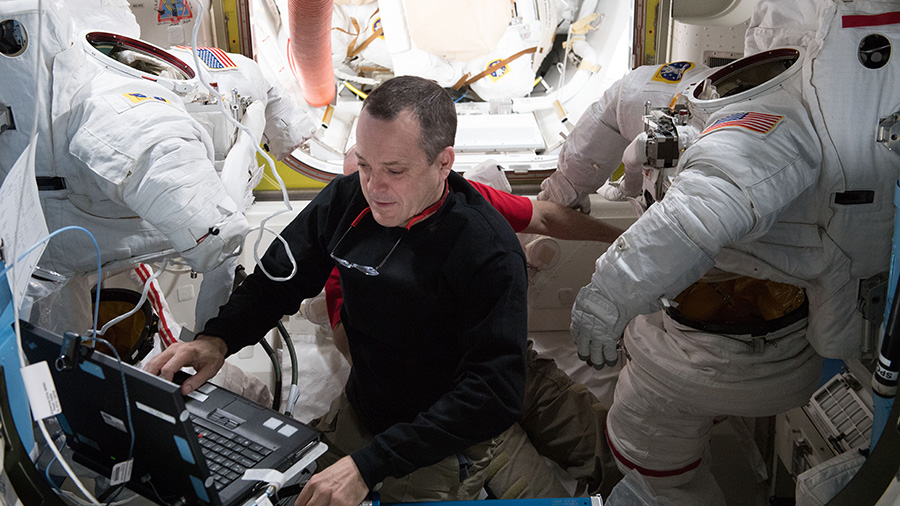
Last month, the incumbent Expedition 55 crew—which, in addition to Feustel and Arnold, also includes U.S. astronaut Scott “Maker” Tingle, Japan’s Norishige Kanai and Russian cosmonauts Anton Shkaplerov and Oleg Artemyev—began a series of internal tasks to prepare for U.S. EVA-50. Tingle replaced a light bulb in an External Television Camera Group (ETVCG), whilst Feustel, Arnold and Kanai worked to prepare their space suits, tools, tethers and Simplified Aid for EVA Rescue (SAFER) backpacks. They also participated in virtual-reality and other training tasks for their activities outside the station. Last week, ground controllers maneuvered the 57.7-foot-long (17.6-meter) Canadarm2 robotic arm and Dextre “hand” to collect a leaky Pump Flow Control Subassembly (PFCS) from the P-6 segment, the farthest-port location of the station’s Integrated Truss Structure (ITS). This unit exhibited a much-publicized ammonia leak back in May 2013 and was removed and replaced, at short notice, by Expedition 35 spacewalkers Chris Cassidy and Tom Marshburn. Unsurprisingly, it has earned the moniker “Leaky”.
Early Wednesday, 16 May, the Expedition 55 crew awoke early, before pressing directly into EVA preparations. Assisting Feustel (EV1) and Arnold (EV2) in the Quest airlock were Tingle and Kanai. The spacewalkers spent about 60 minutes “pre-breathing” on masks and Quest’s inner “equipment lock” was depressed from its ambient 14.7 psi to 10.2 psi, allowing for suit checks and purging. It was then repressed back up to 14.7 psi, enabling the astronauts to undertake a nominal pre-breathing regimen and 50 minutes of in-suit light exercise. At length, Tingle and Kanai transferred the fully suited duo from the equipment lock into the outer “crew lock” and closed the connecting hatches. Depressurization of the crew lock commenced shortly afterwards and reached a condition of near-vacuum at 0.5 psi. Feustel and Arnold transferred their suits’ life-support utilities onto battery power and U.S. EVA-50 got underway at 7:39 a.m. Today’s activities were led by Flight Director Anthony Vahera and Lead EVA-50 Spacewalk Officer Jordan Lindsey, together with veteran astronaut Barry “Butch” Wilmore at the Capcom’s console in the Mission Control Center (MCC) at the Johnson Space Center (JSC) in Houston, Texas.

Feustel moved outside first and set up safety tethers, quickly followed by Arnold, who brought out a Crew Lock Bag (CLB). Making the fourth EVA of his career, former high school teacher Arnold translated up the airlock “spur”, across the truss and onto the U.S. Destiny lab, to reach External Stowage Platform (ESP)-1, where the spare PFCS was situated. He temporarily stowed his CLB and was joined in short order by Feustel, who had taken the nadir route from the airlock, translating “underneath” the lab. Feustel set up an Articulating Portable Foot Restraint (APFR) and Arnold set up a Multi-Use Tether (MUT) End Effector Ballstack Assembly. The pair worked together with remove multi-layered insulation to expose the spare PFCS and Arnold hopped into the APFR and installed a pair of scoops to enable them to maneuver the bulky unit.
Working briskly, and still barely an hour into their planned 6.5 hours of activities, the veteran spacewalkers made their way to Dextre’s Enhanced Orbital Replacement Unit Temporary Platform (EOTP), where the degraded PFCS was located. Feustel removed it and the duo returned it to the MUT End Effector Ballstack Assembly. Next, they detached the spare PFCS from its ESP-1 perch, inspected and photo-documented it, before translating it out to the EOTP for installation. With the spare in place, the astronauts returned to ESP-1 to remove the degraded PFCS from the ballstack assembly, install it onto ESP-1 and attach multi-layered insulation for protection.
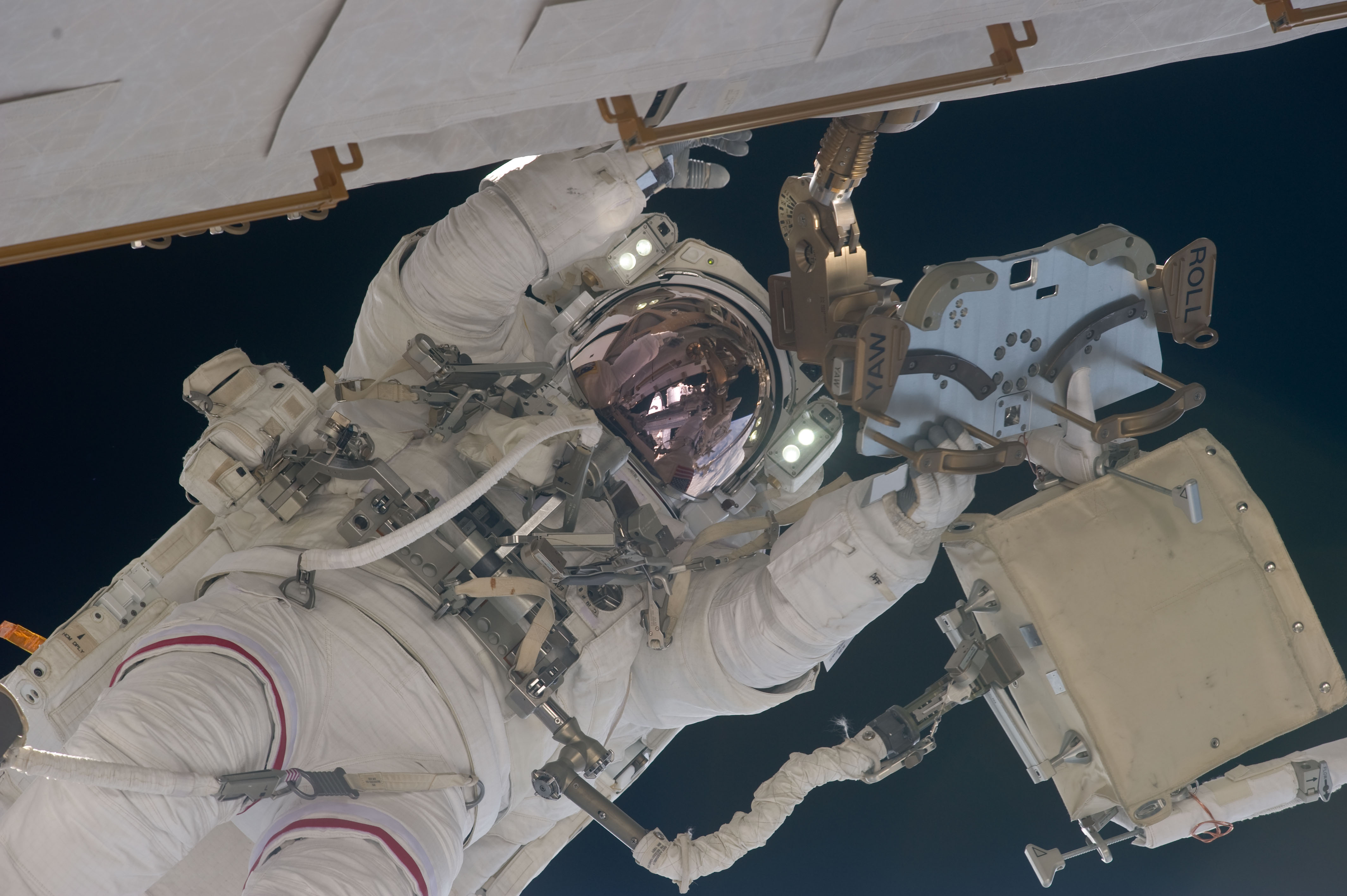
With the principal goal of U.S. EVA-50 behind them, Feustel and Arnold now parted ways to embark on other tasks. Arnold flew in the APFR, deftly maneuvered by Tingle at the Canadarm2 controls, out to the Camera Group (CG)-13 work site, where Feustel joined him to remove the failed camera group and install the replacement. Stowing the failed camera group in an ORU Bag, Feustel carried this back to the Quest airlock and picked up a spare Space-to-Ground Transmitter Receiver Controller (SGTRC). He translated to the Z-1 truss—which sits atop the station’s Unity node—and pulled out a failed SGTRC and fitted the replacement. This concluded Feustel’s final major task of U.S. EVA-50, after which he cleaned up his work site and returned to the airlock to join Arnold, who had wrapped up his own final responsibilities of closing out the CP-13 task and cleaning up his own work site on the S-0 truss. Working so far ahead of schedule, the pair were assigned a couple of get-ahead tasks, before returning to Quest at 2:10 p.m. EDT after six hours and 31 minutes.
In his remarks from last week’s EVA briefing, ISS Operations Integration Manager Kenny Todd made reference to the original plan for another spacewalk—U.S. EVA-51—which was targeted for the end of May. On this excursion, Feustel and Arnold will primarily install brackets and high-definition cameras onto the forward “end” of the station’s Harmony node, in readiness for Commercial Crew operations. However, with the impending arrival of Orbital ATK’s OA-9 Cygnus on 24 May, the departure of Expedition 55 crewmen Shkaplerov, Tingle and Kanai on 3 June and the arrival of their replacements, Sergei Prokopiev of Russia, Alexander Gerst of Germany and NASA’s Serena Auñón-Chancellor on 8 June, it was considered more prudent to move U.S. EVA-51 until 14 June.




